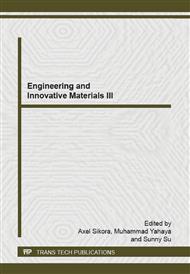p.119
p.124
p.129
p.133
p.138
p.145
p.149
p.154
p.159
Glass Ceramization as an Alternative Production Route of Forsterite Glass-Ceramics for Possible Multipurpose Uses
Abstract:
Homogenous, transparent and bubble-free glass was produced through the addition of an extra silica as a replacement for its structurally analogous AlPO4 in an aluminophosphosilicate base glass. FT-IR, DSC, XRD and SEM coupled with EDX, were all used to characterize the obtained glass, and to establish the effect of silica as a substitution for AlPO4 on the vibrational spectra and crystallization behavior of the obtained glass.Silica was found to lower the wavenumber of the main stretching vibrational band of aluminophosphosilicate glass, thus counterbalancing the increment in the wavenumber of the main stretching band caused by P2O5 in the former base glass. The obtained glass crystallized in bulk at relatively low temperatures, and the first phase to crystallize was enstatite. As temperature was increased, both enstatite and forsterite coexisted. At yet higher temperatures, forsterite was the predominantly crystallizing phase with just traces of enstatite.Thus, it is believed that glass ceramization represents a challenging and yet a promising fabrication route with many technological advantages, over other making techniques, such as sol-gel and solid-state or solid solution routes, for production of forsterite-enstatite and forsterite ceramics. The obtained glass-ceramics are possible candidates for advanced applications, utilizing properties of forsterite, such as bioactivity, dielectricity and birefringence, among many others.
Info:
Periodical:
Pages:
138-144
Citation:
Online since:
October 2014
Authors:
Keywords:
Price:
Сopyright:
© 2014 Trans Tech Publications Ltd. All Rights Reserved
Share:
Citation:


